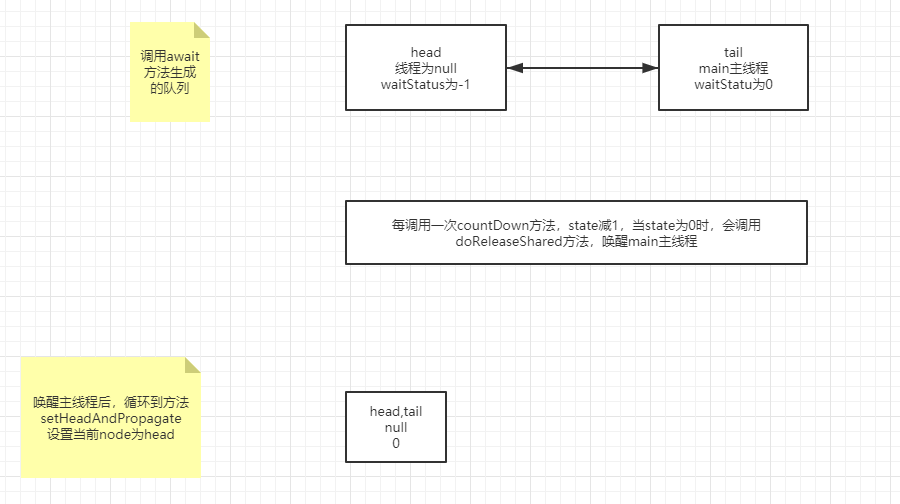源码:
内部类Sync
private static final class Sync extends AbstractQueuedSynchronizer {
private static final long serialVersionUID = 4982264981922014374L;
//调用AQS类的setState设置状态位
Sync(int count) {
setState(count);
}
int getCount() {
return getState();
}
protected int tryAcquireShared(int acquires) {
return (getState() == 0) ? 1 : -1;
}
protected boolean tryReleaseShared(int releases) {
// Decrement count; signal when transition to zero
for (;;) {
int c = getState();
if (c == 0)
return false;
int nextc = c-1;
if (compareAndSetState(c, nextc))
return nextc == 0;
}
}
}
CountDownLatch初始化
public CountDownLatch(int count) {
if (count < 0) throw new IllegalArgumentException("count < 0");
this.sync = new Sync(count);
}
可以设置AQS中的state为count
阻塞分析
await
public void await() throws InterruptedException {
sync.acquireSharedInterruptibly(1);
}
acquireSharedInterruptibly
public final void acquireSharedInterruptibly(int arg)
throws InterruptedException {
if (Thread.interrupted())
throw new InterruptedException();
if (tryAcquireShared(arg) < 0)
doAcquireSharedInterruptibly(arg);
}
具体如下:
1、检测中断标志位
2、调用tryAcquireShared方法来检查AQS标志位state是否等于0,如果state等于0,则说明不需要等待,立即返回,否则进行3
3、调用doAcquireSharedInterruptibly方法进入AQS同步队列进行等待,并不断的自旋检测是否需要唤醒
doAcquireSharedInterruptibly
private void doAcquireSharedInterruptibly(int arg)
throws InterruptedException {
final Node node = addWaiter(Node.SHARED);//加入队列尾部
boolean failed = true;//是否成功标志
try {
for (;;) {
final Node p = node.predecessor();//前驱
//如果到head的下一个,因为head是拿到资源的线程,此时node被唤醒,很可能是head用完资源来唤醒自己的
if (p == head) {
int r = tryAcquireShared(arg);
if (r >= 0) { //如果大于零,则说明需要唤醒
setHeadAndPropagate(node, r);//将head指向自己,还有剩余资源可以再唤醒之后的线程
p.next = null; // help GC
failed = false;
return;
}
}
//判断状态,寻找安全点,进入waiting状态,等着被unpark()或interrupt()
if (shouldParkAfterFailedAcquire(p, node) &&
parkAndCheckInterrupt())
throw new InterruptedException();
}
} finally {
if (failed)
cancelAcquire(node);
}
}
addWaiter(Node.SHARED),这里将会新增两个node
第一轮循环创建一个new Node(),空节点,线程也为空
第二轮将Node.SHARED加入到队列中,prev指向head
在最后一次release之前,tryAcquireShared会为-1
shouldParkAfterFailedAcquire(Node, Node)
1、源码:
/**
* Checks and updates status for a node that failed to acquire.
* Returns true if thread should block. This is the main signal
* control in all acquire loops. Requires that pred == node.prev.
*
* @param pred node's predecessor holding status
* @param node the node
* @return {@code true} if thread should block
*/
private static boolean shouldParkAfterFailedAcquire(Node pred, Node node) {
int ws = pred.waitStatus; // 获取前驱结点的状态值
if (ws == Node.SIGNAL) // 若前驱结点的状态为SIGNAL状态的话,那么该结点就不要想事了,直接返回true准备休息
/*
* This node has already set status asking a release
* to signal it, so it can safely park.
*/
return true;
if (ws > 0) {
/*
* Predecessor was cancelled. Skip over predecessors and
* indicate retry.
*/
// 若前驱结点的状态为CANCELLED状态的话,那么就一直向前遍历,直到找到一个不为CANCELLED状态的结点
do {
node.prev = pred = pred.prev;
} while (pred.waitStatus > 0);
pred.next = node;
} else {
/*
* waitStatus must be 0 or PROPAGATE. Indicate that we
* need a signal, but don't park yet. Caller will need to
* retry to make sure it cannot acquire before parking.
*/
// 剩下的结点状态,则设置其为SIGNAL状态,然后返回false标志等外层循环再次判断
compareAndSetWaitStatus(pred, ws, Node.SIGNAL);
}
return false;
}
2、shouldParkAfterFailedAcquire主要是检测前驱结点状态,前驱结点为SIGNAL的话,则新结点可以安安心心休息了;
如果前驱结点大于零,说明前驱结点处于CANCELLED状态,那么则以入参pred前驱为起点,一直往前找,直到找到最近一个正常等待状态的结点;
如果前驱结点小于零,那么就将前驱结点设置为SIGNAL状态,然后返回false依赖acquireQueued的自旋再次判断是否需要进行休息;
第一次进入,ws为0
compareAndSetWaitStatus将pred的waitStatus设置为Node.SIGNAL
第二次进入就直接return true
parkAndCheckInterrupt()
1、源码:
/**
* Convenience method to park and then check if interrupted
*
* @return {@code true} if interrupted
*/
private final boolean parkAndCheckInterrupt() {
LockSupport.park(this); // 阻塞等待
return Thread.interrupted(); // 被唤醒后查看是否有被中断过否?
}
2、parkAndCheckInterrupt首先调用park让线程进入等待状态,然后当park阻塞被唤醒后,再次检测是否曾经被中断过;
而被唤醒有两种情况,一个是利用unpark唤醒,一个是利用interrupt唤醒;
main线程会进入上述代码,阻塞main线程。
释放分析
countDown
public void countDown() {
sync.releaseShared(1);
}
public final boolean releaseShared(int arg) {
if (tryReleaseShared(arg)) {
doReleaseShared();
return true;
}
return false;
}
Sync内部类中的tryReleaseShared
protected boolean tryReleaseShared(int releases) {
// Decrement count; signal when transition to zero
for (;;) {
int c = getState();
if (c == 0)
return false;
int nextc = c-1;
if (compareAndSetState(c, nextc))
return nextc == 0;
}
}
可见只有最后一次release的时候才会进入到doReleaseShared
doReleaseShared
private void doReleaseShared() {
for (;;) {
Node h = head;
if (h != null && h != tail) {
int ws = h.waitStatus;
if (ws == Node.SIGNAL) {
if (!compareAndSetWaitStatus(h, Node.SIGNAL, 0))
continue; // loop to recheck cases
unparkSuccessor(h);
}
else if (ws == 0 &&
!compareAndSetWaitStatus(h, 0, Node.PROPAGATE))
continue; // loop on failed CAS
}
if (h == head) // loop if head changed
break;
}
}
进入上述代码时,head的waitStatus在上述shouldParkAfterFailedAcquire中设置为了Node.SIGNAL
所以这里会调用unparkSuccessor(h)
unparkSuccessor
private void unparkSuccessor(Node node) {
/*
* If status is negative (i.e., possibly needing signal) try
* to clear in anticipation of signalling. It is OK if this
* fails or if status is changed by waiting thread.
*/
int ws = node.waitStatus;
if (ws < 0)
compareAndSetWaitStatus(node, ws, 0);
/*
* Thread to unpark is held in successor, which is normally
* just the next node. But if cancelled or apparently null,
* traverse backwards from tail to find the actual
* non-cancelled successor.
*/
Node s = node.next;
if (s == null || s.waitStatus > 0) {
s = null;
for (Node t = tail; t != null && t != node; t = t.prev)
if (t.waitStatus <= 0)
s = t;
}
if (s != null)
LockSupport.unpark(s.thread);
}
这里s=node.next,node为head,s的线程为main线程,这里释放main线程。
流程
